Integrating Lean Supply Chain Management with SAP Systems
VerifiedAdded on 2022/09/18
|6
|993
|22
Report
AI Summary
This report delves into the realm of Lean Supply Chain Management and its practical integration with SAP systems. It begins by defining Lean Manufacturing, emphasizing waste reduction, continuous improvement, and the pull supply chain system. The report then outlines the core principles of lean management, including defining customer value, mapping the value stream, creating flow, establishing a pull system, and pursuing perfection. The core of the report explores how Lean principles, such as the Kanban system and Heijunka (production leveling), can be seamlessly incorporated into SAP to improve efficiency and maintain production quality. It highlights SAP's capabilities in facilitating communication, monitoring production processes, and balancing production loads over time. The report concludes by emphasizing the importance of integrating lean management with SAP to enhance the quality of production and foster effective communication across all departments, ultimately improving the overall efficiency of the supply chain.
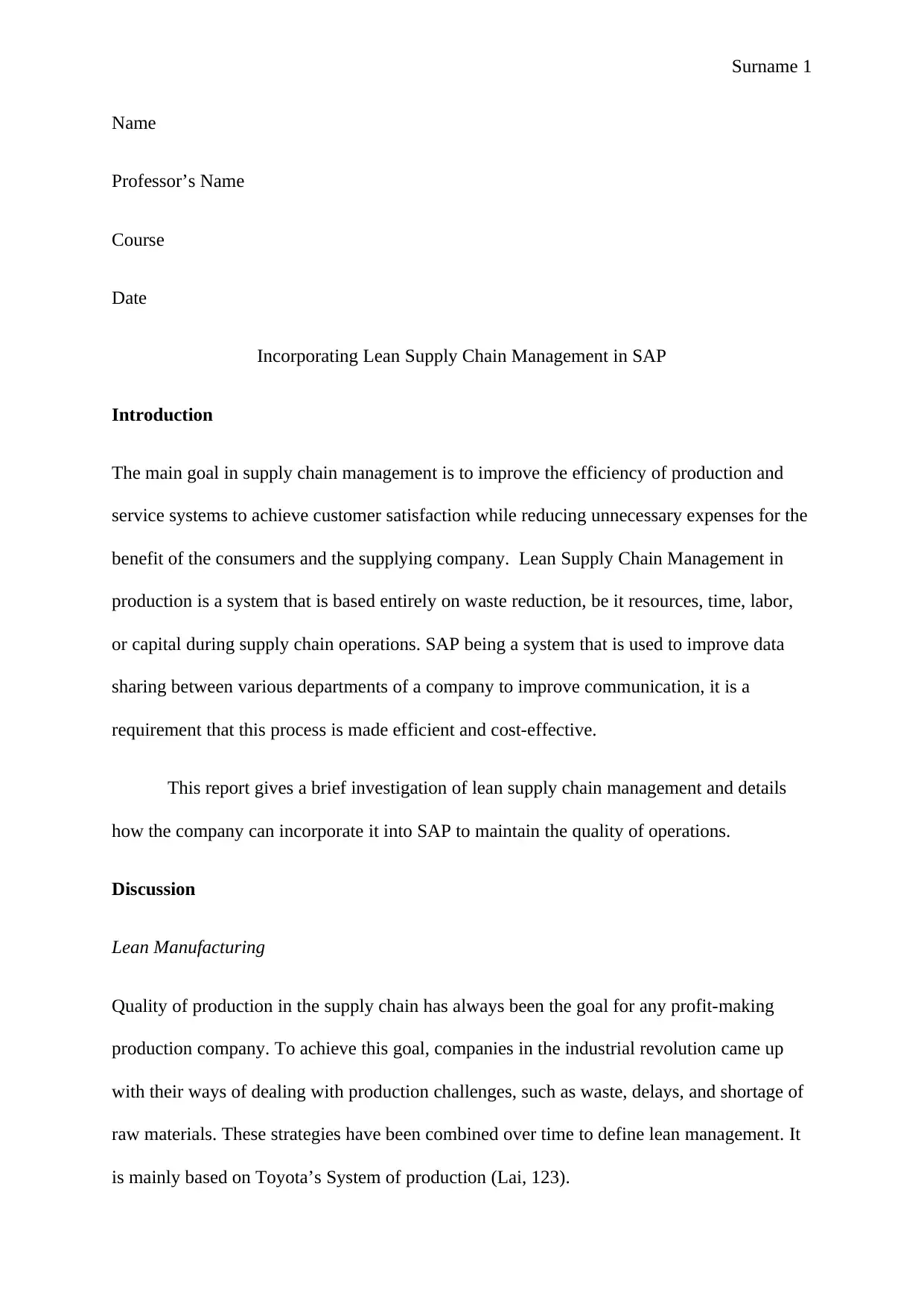
Surname 1
Name
Professor’s Name
Course
Date
Incorporating Lean Supply Chain Management in SAP
Introduction
The main goal in supply chain management is to improve the efficiency of production and
service systems to achieve customer satisfaction while reducing unnecessary expenses for the
benefit of the consumers and the supplying company. Lean Supply Chain Management in
production is a system that is based entirely on waste reduction, be it resources, time, labor,
or capital during supply chain operations. SAP being a system that is used to improve data
sharing between various departments of a company to improve communication, it is a
requirement that this process is made efficient and cost-effective.
This report gives a brief investigation of lean supply chain management and details
how the company can incorporate it into SAP to maintain the quality of operations.
Discussion
Lean Manufacturing
Quality of production in the supply chain has always been the goal for any profit-making
production company. To achieve this goal, companies in the industrial revolution came up
with their ways of dealing with production challenges, such as waste, delays, and shortage of
raw materials. These strategies have been combined over time to define lean management. It
is mainly based on Toyota’s System of production (Lai, 123).
Name
Professor’s Name
Course
Date
Incorporating Lean Supply Chain Management in SAP
Introduction
The main goal in supply chain management is to improve the efficiency of production and
service systems to achieve customer satisfaction while reducing unnecessary expenses for the
benefit of the consumers and the supplying company. Lean Supply Chain Management in
production is a system that is based entirely on waste reduction, be it resources, time, labor,
or capital during supply chain operations. SAP being a system that is used to improve data
sharing between various departments of a company to improve communication, it is a
requirement that this process is made efficient and cost-effective.
This report gives a brief investigation of lean supply chain management and details
how the company can incorporate it into SAP to maintain the quality of operations.
Discussion
Lean Manufacturing
Quality of production in the supply chain has always been the goal for any profit-making
production company. To achieve this goal, companies in the industrial revolution came up
with their ways of dealing with production challenges, such as waste, delays, and shortage of
raw materials. These strategies have been combined over time to define lean management. It
is mainly based on Toyota’s System of production (Lai, 123).
Paraphrase This Document
Need a fresh take? Get an instant paraphrase of this document with our AI Paraphraser
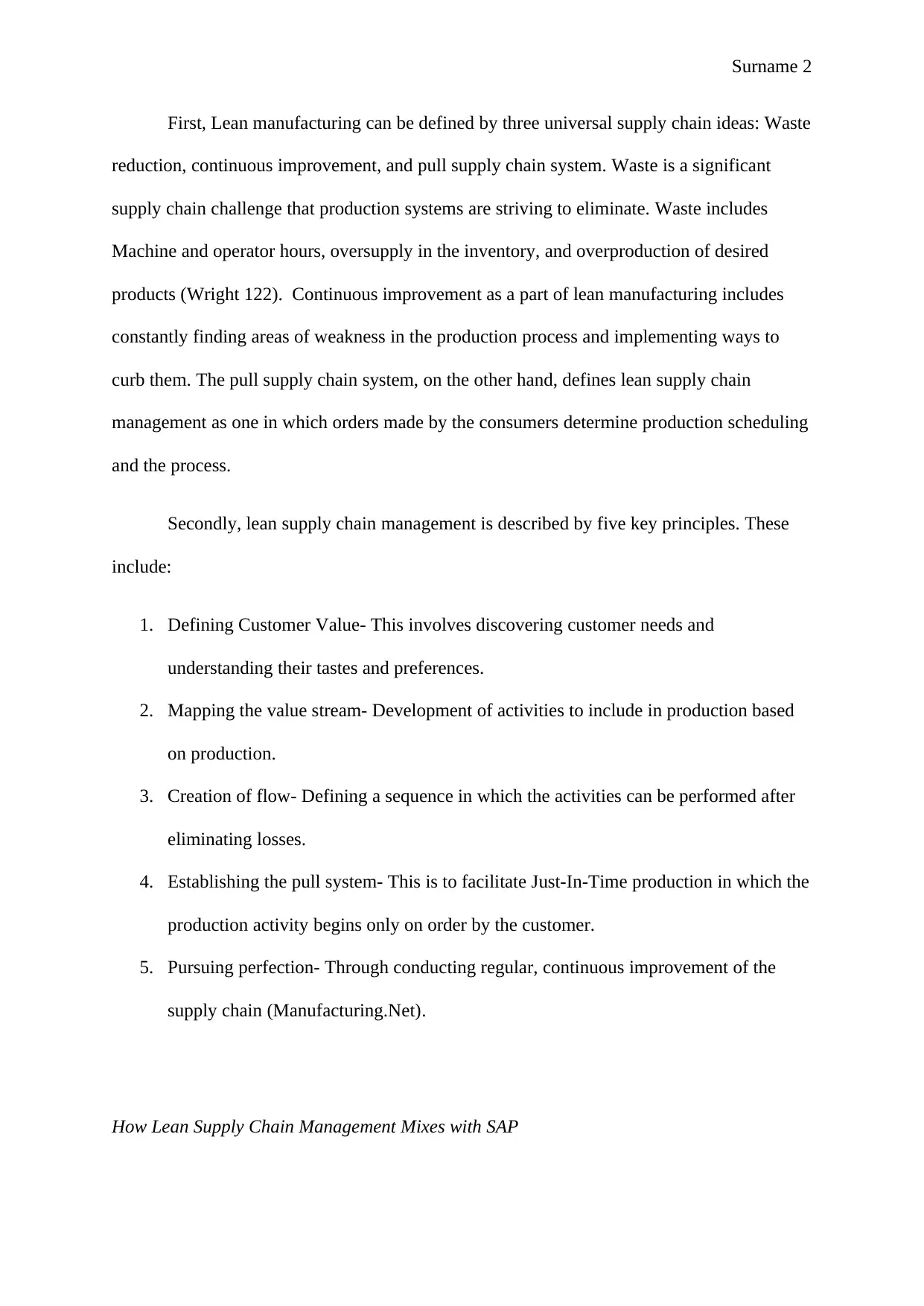
Surname 2
First, Lean manufacturing can be defined by three universal supply chain ideas: Waste
reduction, continuous improvement, and pull supply chain system. Waste is a significant
supply chain challenge that production systems are striving to eliminate. Waste includes
Machine and operator hours, oversupply in the inventory, and overproduction of desired
products (Wright 122). Continuous improvement as a part of lean manufacturing includes
constantly finding areas of weakness in the production process and implementing ways to
curb them. The pull supply chain system, on the other hand, defines lean supply chain
management as one in which orders made by the consumers determine production scheduling
and the process.
Secondly, lean supply chain management is described by five key principles. These
include:
1. Defining Customer Value- This involves discovering customer needs and
understanding their tastes and preferences.
2. Mapping the value stream- Development of activities to include in production based
on production.
3. Creation of flow- Defining a sequence in which the activities can be performed after
eliminating losses.
4. Establishing the pull system- This is to facilitate Just-In-Time production in which the
production activity begins only on order by the customer.
5. Pursuing perfection- Through conducting regular, continuous improvement of the
supply chain (Manufacturing.Net).
How Lean Supply Chain Management Mixes with SAP
First, Lean manufacturing can be defined by three universal supply chain ideas: Waste
reduction, continuous improvement, and pull supply chain system. Waste is a significant
supply chain challenge that production systems are striving to eliminate. Waste includes
Machine and operator hours, oversupply in the inventory, and overproduction of desired
products (Wright 122). Continuous improvement as a part of lean manufacturing includes
constantly finding areas of weakness in the production process and implementing ways to
curb them. The pull supply chain system, on the other hand, defines lean supply chain
management as one in which orders made by the consumers determine production scheduling
and the process.
Secondly, lean supply chain management is described by five key principles. These
include:
1. Defining Customer Value- This involves discovering customer needs and
understanding their tastes and preferences.
2. Mapping the value stream- Development of activities to include in production based
on production.
3. Creation of flow- Defining a sequence in which the activities can be performed after
eliminating losses.
4. Establishing the pull system- This is to facilitate Just-In-Time production in which the
production activity begins only on order by the customer.
5. Pursuing perfection- Through conducting regular, continuous improvement of the
supply chain (Manufacturing.Net).
How Lean Supply Chain Management Mixes with SAP
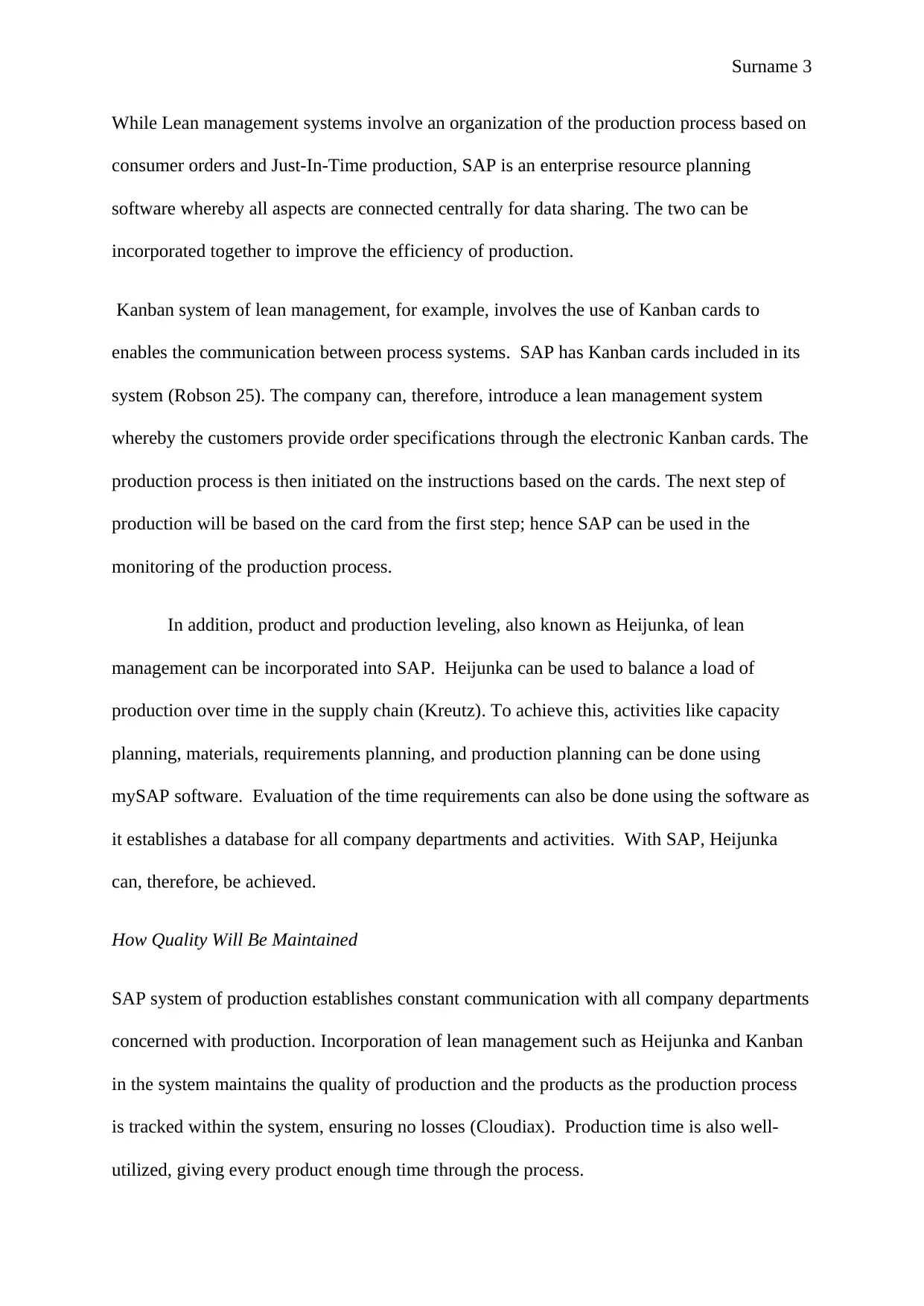
Surname 3
While Lean management systems involve an organization of the production process based on
consumer orders and Just-In-Time production, SAP is an enterprise resource planning
software whereby all aspects are connected centrally for data sharing. The two can be
incorporated together to improve the efficiency of production.
Kanban system of lean management, for example, involves the use of Kanban cards to
enables the communication between process systems. SAP has Kanban cards included in its
system (Robson 25). The company can, therefore, introduce a lean management system
whereby the customers provide order specifications through the electronic Kanban cards. The
production process is then initiated on the instructions based on the cards. The next step of
production will be based on the card from the first step; hence SAP can be used in the
monitoring of the production process.
In addition, product and production leveling, also known as Heijunka, of lean
management can be incorporated into SAP. Heijunka can be used to balance a load of
production over time in the supply chain (Kreutz). To achieve this, activities like capacity
planning, materials, requirements planning, and production planning can be done using
mySAP software. Evaluation of the time requirements can also be done using the software as
it establishes a database for all company departments and activities. With SAP, Heijunka
can, therefore, be achieved.
How Quality Will Be Maintained
SAP system of production establishes constant communication with all company departments
concerned with production. Incorporation of lean management such as Heijunka and Kanban
in the system maintains the quality of production and the products as the production process
is tracked within the system, ensuring no losses (Cloudiax). Production time is also well-
utilized, giving every product enough time through the process.
While Lean management systems involve an organization of the production process based on
consumer orders and Just-In-Time production, SAP is an enterprise resource planning
software whereby all aspects are connected centrally for data sharing. The two can be
incorporated together to improve the efficiency of production.
Kanban system of lean management, for example, involves the use of Kanban cards to
enables the communication between process systems. SAP has Kanban cards included in its
system (Robson 25). The company can, therefore, introduce a lean management system
whereby the customers provide order specifications through the electronic Kanban cards. The
production process is then initiated on the instructions based on the cards. The next step of
production will be based on the card from the first step; hence SAP can be used in the
monitoring of the production process.
In addition, product and production leveling, also known as Heijunka, of lean
management can be incorporated into SAP. Heijunka can be used to balance a load of
production over time in the supply chain (Kreutz). To achieve this, activities like capacity
planning, materials, requirements planning, and production planning can be done using
mySAP software. Evaluation of the time requirements can also be done using the software as
it establishes a database for all company departments and activities. With SAP, Heijunka
can, therefore, be achieved.
How Quality Will Be Maintained
SAP system of production establishes constant communication with all company departments
concerned with production. Incorporation of lean management such as Heijunka and Kanban
in the system maintains the quality of production and the products as the production process
is tracked within the system, ensuring no losses (Cloudiax). Production time is also well-
utilized, giving every product enough time through the process.
⊘ This is a preview!⊘
Do you want full access?
Subscribe today to unlock all pages.

Trusted by 1+ million students worldwide
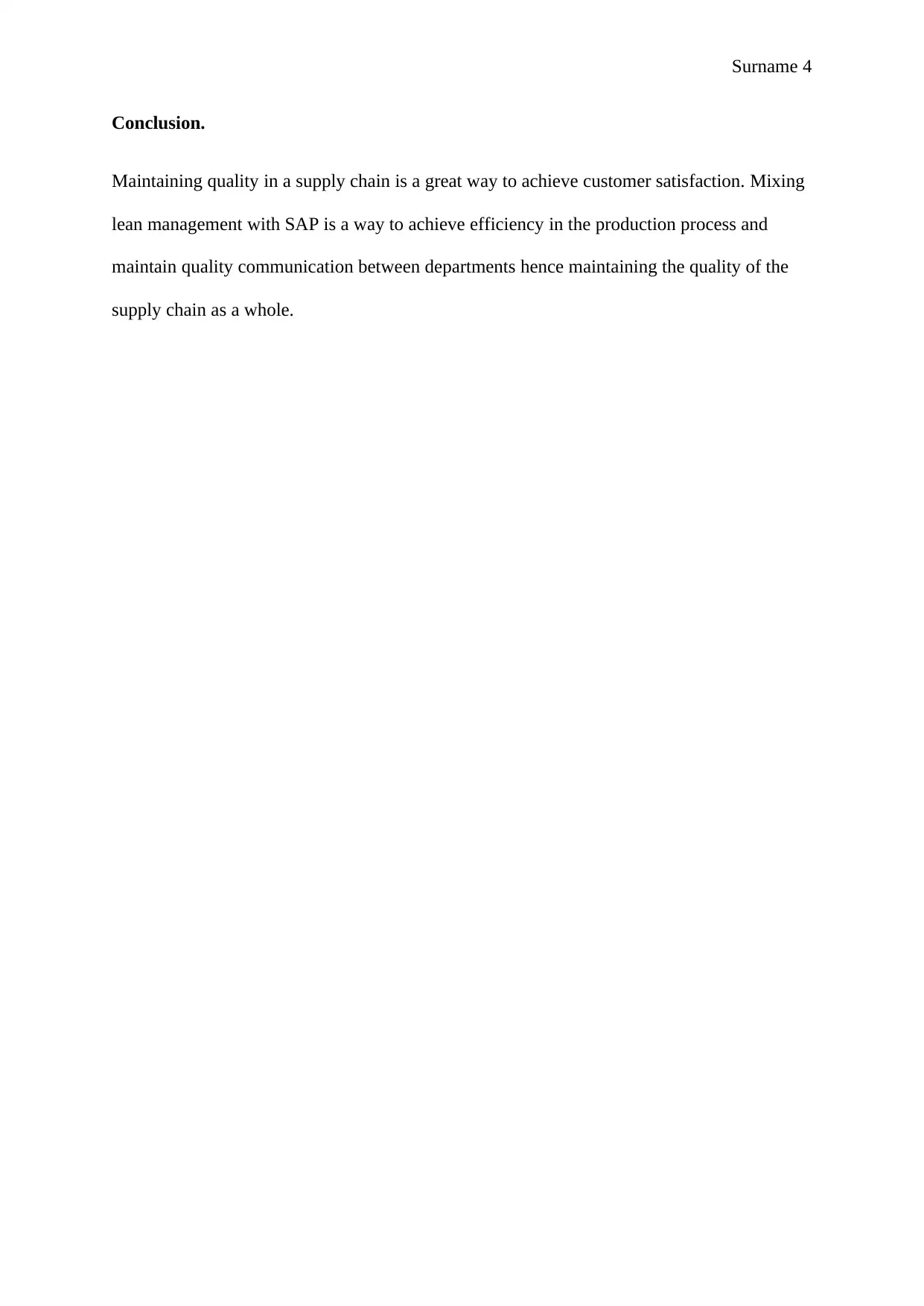
Surname 4
Conclusion.
Maintaining quality in a supply chain is a great way to achieve customer satisfaction. Mixing
lean management with SAP is a way to achieve efficiency in the production process and
maintain quality communication between departments hence maintaining the quality of the
supply chain as a whole.
Conclusion.
Maintaining quality in a supply chain is a great way to achieve customer satisfaction. Mixing
lean management with SAP is a way to achieve efficiency in the production process and
maintain quality communication between departments hence maintaining the quality of the
supply chain as a whole.
Paraphrase This Document
Need a fresh take? Get an instant paraphrase of this document with our AI Paraphraser
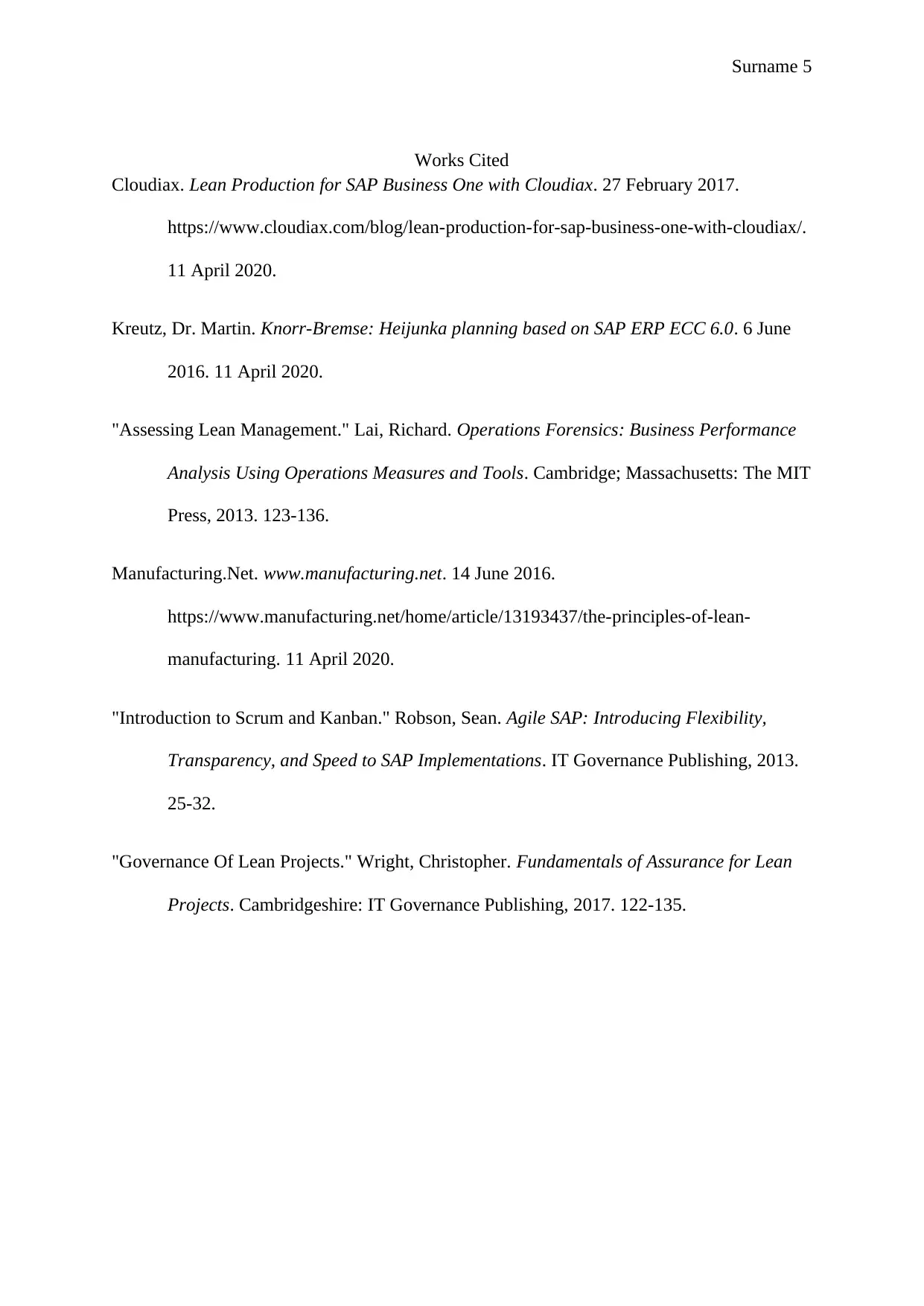
Surname 5
Works Cited
Cloudiax. Lean Production for SAP Business One with Cloudiax. 27 February 2017.
https://www.cloudiax.com/blog/lean-production-for-sap-business-one-with-cloudiax/.
11 April 2020.
Kreutz, Dr. Martin. Knorr-Bremse: Heijunka planning based on SAP ERP ECC 6.0. 6 June
2016. 11 April 2020.
"Assessing Lean Management." Lai, Richard. Operations Forensics: Business Performance
Analysis Using Operations Measures and Tools. Cambridge; Massachusetts: The MIT
Press, 2013. 123-136.
Manufacturing.Net. www.manufacturing.net. 14 June 2016.
https://www.manufacturing.net/home/article/13193437/the-principles-of-lean-
manufacturing. 11 April 2020.
"Introduction to Scrum and Kanban." Robson, Sean. Agile SAP: Introducing Flexibility,
Transparency, and Speed to SAP Implementations. IT Governance Publishing, 2013.
25-32.
"Governance Of Lean Projects." Wright, Christopher. Fundamentals of Assurance for Lean
Projects. Cambridgeshire: IT Governance Publishing, 2017. 122-135.
Works Cited
Cloudiax. Lean Production for SAP Business One with Cloudiax. 27 February 2017.
https://www.cloudiax.com/blog/lean-production-for-sap-business-one-with-cloudiax/.
11 April 2020.
Kreutz, Dr. Martin. Knorr-Bremse: Heijunka planning based on SAP ERP ECC 6.0. 6 June
2016. 11 April 2020.
"Assessing Lean Management." Lai, Richard. Operations Forensics: Business Performance
Analysis Using Operations Measures and Tools. Cambridge; Massachusetts: The MIT
Press, 2013. 123-136.
Manufacturing.Net. www.manufacturing.net. 14 June 2016.
https://www.manufacturing.net/home/article/13193437/the-principles-of-lean-
manufacturing. 11 April 2020.
"Introduction to Scrum and Kanban." Robson, Sean. Agile SAP: Introducing Flexibility,
Transparency, and Speed to SAP Implementations. IT Governance Publishing, 2013.
25-32.
"Governance Of Lean Projects." Wright, Christopher. Fundamentals of Assurance for Lean
Projects. Cambridgeshire: IT Governance Publishing, 2017. 122-135.

Surname 6
⊘ This is a preview!⊘
Do you want full access?
Subscribe today to unlock all pages.

Trusted by 1+ million students worldwide
1 out of 6
Related Documents
Your All-in-One AI-Powered Toolkit for Academic Success.
+13062052269
info@desklib.com
Available 24*7 on WhatsApp / Email
![[object Object]](/_next/static/media/star-bottom.7253800d.svg)
Unlock your academic potential
Copyright © 2020–2025 A2Z Services. All Rights Reserved. Developed and managed by ZUCOL.





